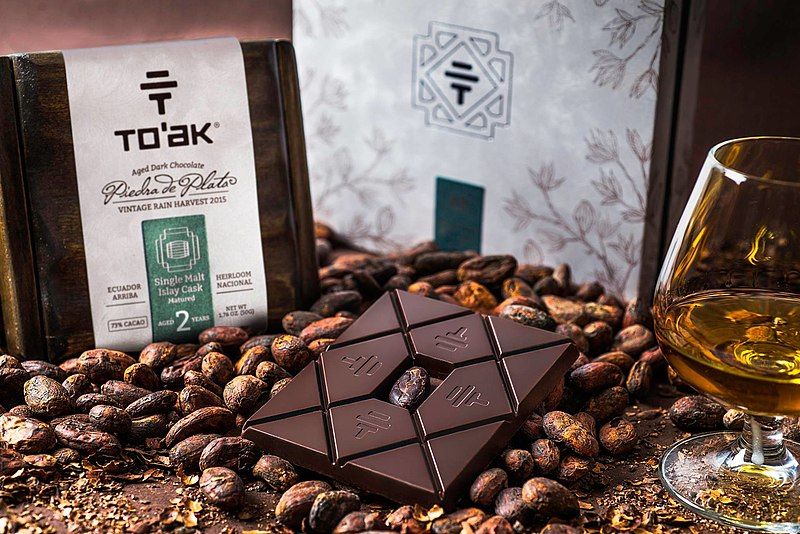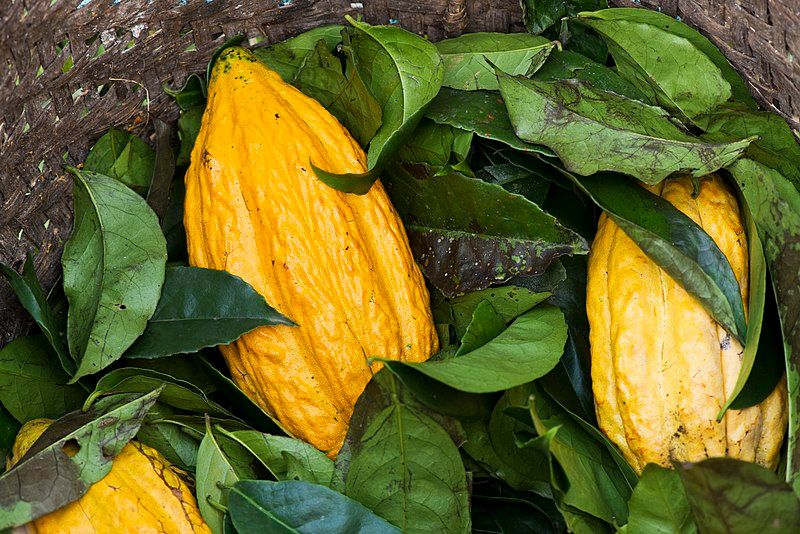Discover To'ak: The World's Most Expensive Chocolate
You might think all chocolates are created equal, but To'ak Chocolate proves otherwise. Let's dive into the world of the most expensive chocolate, and find out what makes it so special.

What is To'ak Chocolate?
To'ak chocolate is a luxury brand originating from Ecuador, renowned for producing some of the world's most exclusive and expensive chocolates.
Crafted from rare Nacional cacao beans, unique to Ecuador's rainforests, each bar is meticulously processed, aged like fine wine, and presented in a handcrafted Spanish Elm box.
The brand marries artisanal craftsmanship with sustainability, ensuring the preservation of Ecuador's unique cacao heritage while delivering an unparalleled gustatory experience.
History of Origin
Originating from Ecuador, To'ak (pronounced Toe-Ahk) prides itself on producing the world's most luxurious and expensive chocolate. Started in 2013 by Jerry Toth, Carl Schweizer, and Dennise Valencia - who really care about rainforests.
When I first heard about it, I was astonished to learn that some of their bars could sell for upwards of $450 for a bar that weighs 50 gram only!
They recognized the exceptional quality of the Nacional cacao beans, native to Ecuador's rainforests, and sought to elevate chocolate-making to an art form.
The Rare Chocolate Find in Ecuador
Toth found something special in a hidden part of Ecuador: old cacao trees that had escaped a big disease back in 1916. These trees had the prized Nacional cacao beans, which many believe are the best in the world.

A long time ago, Swiss chocolate makers even named this chocolate "Arriba" because it was found "upriver" in Ecuador. But even though these beans were so good, local farmers didn’t get paid more for them.
This meant that these top-notch beans often got mixed with regular ones, just like mixing really fancy grapes with cheap ones.
Toth and Schweizer teamed up with local farmers in Piedra de Plata, including Elio Cantos, whose great-granddad planted some of the really old cacao trees they use.
Together in Ecuador, they make chocolate only from these special cacao beans. Making this chocolate isn’t easy. First, they let the beans ferment for about a week. Then, they roast, shell, and grind them.
Why is To'ak So Expensive?
Unique Cacao Beans
To’ak doesn't grow all their own cacao beans. Instead, they buy from local farmers. But they don’t just buy any beans. They pay more than what others might to make sure they get the best ones.
After buying the beans, To’ak handles everything, from start to finish, to make their chocolate. To'ak sources its beans from rare Nacional cacao trees.
These trees are unique to Ecuador and are known for producing some of the finest cacao beans in the world. The age of the trees, sometimes over 100 years old, plays a crucial role in the flavor profile of the chocolate.
Limited Supply
The beans are sourced from just 14 select farms and belong to the exceptionally rare Nacional variety. Through six careful manual stages, they meticulously select only the very best beans for their chocolate.
Meticulous Processing
They farm their cacao without using extra water, kind of like "dry farming." This means that To'ak's chocolate tastes a bit different every year, depending on the weather. It's similar to how some years of coffee or wine might taste different from others.
To’ak's devotion to creating the finest chocolate is evident in their meticulous crafting process. Here's a deep dive:
1. Harvesting: In 2015, To’ak undertook the initial step of collecting cacao. Harvesting is a crucial stage, determining the quality of the beans and, by extension, the chocolate's final taste.
2. Aging: Rather than rushing to the next phase, To’ak chose a patient approach. They let the beans age for an impressive three years. Aging allows the beans to develop richer, more complex flavors, enhancing the final product's depth.
3. Fermentation with Spanish Elm: Once aged to perfection, the beans underwent fermentation, an essential step in developing the chocolate's flavor profile. To’ak leveraged Spanish elm wood for this stage. The choice of wood can influence the taste, and Spanish elm is known to impart unique nuances to the cacao beans.
4. Roasting: Post-fermentation, the beans were roasted. Roasting is where the beans' true flavors are awakened, turning them from a raw, bitter taste to the more familiar chocolatey notes we adore.
5. Two-Stage Conching: Conching refines the chocolate, making it smooth and homogenous. The cocoa butter naturally present within the chocolate is evenly distributed during this process, ensuring a consistent texture and flavor.
To’ak didn't settle for the standard procedure. They opted for a two-round approach: an initial nine-hour conching session, followed by an even more rigorous 23.5-hour stretch.
This lengthy process showcases their commitment to achieving unparalleled smoothness and flavor in their chocolate.
In essence, To’ak’s crafting method is a testament to their unwavering commitment to quality, underscoring the lengths they will go to in the name of exceptional chocolate.

Aging Process
Cacao beans contain about 50% fat, which, when pressed, yields "cacao butter."
This butter is often an ingredient in select chocolates and skincare items. At To’ak, they generally don't add extra cacao butter, but its natural presence aids in the chocolate's aging process.
A notable feature of cacao butter is its knack for absorbing varied aromas.
To’ak is doing something really cool with their chocolate. Just like barrels can change the taste of drinks like whiskey, To’ak uses them to give their chocolate new flavors. They put their chocolate in different barrels, like those used for bourbon or tequila.
Aging chocolate varies in duration. The Ecuadorian wood-aged versions take up to six years, while changes in the cognac edition are noticeable within a year, though they continue to mature over time.
The To'ak Experience
When you invest in a bar of To'ak, you're not just paying for chocolate; you're paying for an experience. Each chocolate bar comes in a handcrafted Spanish Elm box.
Inside, you'll find the chocolate bar, wooden tongs (to avoid melting the chocolate with your fingers), and a booklet that details the chocolate's origin such as the Master Series that has undergone a maturation process for 8 years and tasting notes.
The first time I tasted To'ak, it was evident that this was no ordinary chocolate. The flavors were deep, rich, and layered, evolving as the chocolate melted on my tongue. It's akin to savoring a fine wine, where every bite or sip can reveal a new nuance.
Is It Worth the Price?
For many, spending hundreds of dollars on a chocolate bar sounds outrageous. But think about it this way: there are wines that cost thousands of dollars, and art pieces that go for millions. To'ak is the art and wine of the chocolate world.
To’ak bars are all about pure chocolate flavor. They don't add extra cacao butter and use only a little organic brown sugar to bring out the taste. So, when you bite into one, it’s all delicious chocolate you’re tasting.
If you're a chocolate connoisseur, or someone looking for a once-in-a-lifetime gustatory experience, then yes, To'ak might be worth the splurge. But for most of us, it serves as a reminder of the lengths to which artisans will go to perfect their craft and produce something truly exceptional.
How is To'ak Different From other Artisanal Chocolates?
Just like how top-notch wines let you taste where the grapes come from, To’ak's dark chocolate lets you experience the special place and year the cacao beans were grown.
What's more, To’ak is doing something cool with their chocolate: they age it, kind of like how wine or whiskey gets better over time.
They put their chocolate in different barrels, like those used for Whisky or Tequila, and even in some special wood from Ecuador. Over time, these chocolates pick up unique flavors and smells from these containers.
The Impact of To'ak
Beyond the price and taste, there's another dimension to To'ak that deserves mention. Their commitment to sustainability and preserving the rare Nacional cacao tree is commendable.
By placing a high value on their product, they indirectly emphasize the value of preserving Ecuador's unique cacao heritage.
They paid the farmers up to eight times the usual Fair Trade rate for cacao, setting a record in the chocolate world.
They are committed to protecting the environment that gifts these ingredients. So, when you indulge in a bar of To'ak, you're also supporting an initiative that aims to make a positive difference in the world.
Benefit of Taking Dark Chocolate
Dark chocolate offers impressive health benefits through its rich flavonoid antioxidants that combat inflammation and support cardiovascular health by improving blood flow and cholesterol profiles.
It contains essential minerals like magnesium and iron while providing gentle stimulation through theobromine and caffeine, enhancing both energy and mood.
As a natural aphrodisiac, dark chocolate contains phenylethylamine which triggers pleasurable sensations similar to those experienced during romance, while its sensory properties—from aroma to texture—can heighten sensual awareness and create an intimate atmosphere.
Regular consumption in moderation (about one ounce daily) may also improve insulin sensitivity and support gut health, making dark chocolate a rare fusion of culinary delight, romantic enhancement, and nutritional benefit.
Concluding Thoughts
As we come to the end of our journey through the opulent world of To'ak, it's clear that this isn't just about chocolate. It's about passion, craftsmanship, and a deep respect for nature and heritage.
Whether or not you decide to splurge on a bar, To'ak's story serves as a testament to the heights of excellence that can be achieved when artisans are driven by passion and purpose.


